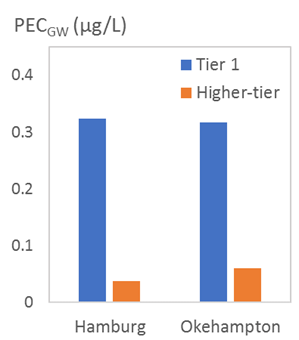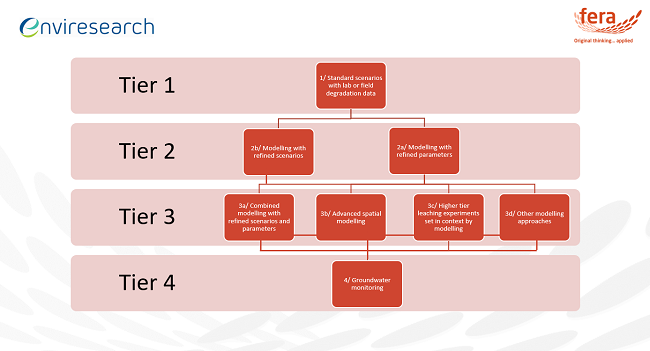
Visit our other sites
-
Fapas - Proficiency Testing
Globally recognised provider of proficiency tests, running over 400 tests annually across an extensive range of matrices and analytes
-
Great Crested Newts Testing
A single sample taken by an ecologist at any time during the newt breeding season can determine their presence or absence, saving you time and money
- Aged Sorption guidelines as a higher tier option for groundwater assessment. A useful refinement option for pesticides and metabolites that currently fail the groundwater assessment.
- See how we can help you

Revisions to the recently approved Guidance on Aged Sorption as a higher tier option for groundwater assessment in the EU. A useful refinement option for pesticides and metabolites that currently fail the groundwater assessment.
The Phytopharmaceuticals section of the European Commission (EC) Standing Committee on Plants, Animals, Food and Feed (PAFF), which plays a key role in ensuring that Union measures on food and feed safety, animal health & welfare as well as plant health are practical and effective, noted and endorsed the ‘Guidance document on aged sorption’ at the meeting on 25-26 January 2021 under Fate & behaviour. It was further agreed that this guidance will be applicable from 1st April 2021 to dossiers submitted under Regulation (EC) no 1107/2009 since then aged sorption studies and modelling have been used as higher-tier option for the risk assessments of pesticides.
The guidance was subsequently approved and published by the European Commission as technical guidance on 21st February 2022 under the Fate and Behaviour section.

Revision of the Guidance on Aged Sorption
The original guidance contained some comments from EU member states, some of which have since been addressed leading to the current update of the guidance document (Revision 1, October 2021).
Regulator’s Instructions
The main update of Revision 1 is that it includes the new Regulator’s Instructions, prepared by AGES as requested by the other member states. The instructions are included as Appendix 8 of the guidance, and provide step-by-step instructions for the kinetic analysis in PEARLNEQ. The instructions are intended as a ‘cook book’ that can be followed step by step, and includes template folders and spreadsheets to assist with setting up the modelling and processing the results. The instructions provide a practical user-friendly manual for the doing the analysis, whilst referring to the guidance text for further detail on data preparation, outliers and acceptability criteria. The templates and instructions ensure clarity and consistency between applicants when presenting the results.
Metabolite Formation Fractions
Only very minor changes were made to the revised guidance, mainly to add some clarifications in response to member state comments. One of the clarifications concerns metabolites that are formed from a parent substance that exhibits aged sorption, and how this impacts the original lower-tier endpoints for these metabolites. The revised guidance recommends that the formation fraction of such metabolites would need to be derived using the DFOP model for degradation of the parent substance. Although not always evident in the observed decline, mathematically the decline of the parent substance is expected to be biphasic due to aged sorption, whereby the DFOP model matches the mathematical representation of this decline. So if the SFO model was used in the original assessment of the parent degradation and metabolite formation endpoints, then the guidance advises that the original study data would need to be refitted using the DFOP model for the parent. If the modelling results are acceptable, then this formation fraction can be accepted for use in the risk assessment. If not acceptable, then the formation fraction may need to be set to the conservative default value of 1, unless a reliable formation fraction can be derived from other datasets.
Fera Science & Enviresearch - Collaboration
Together with collaborators, Enviresearch/Fera have been working with the Chemicals Regulation Directorate (CRD) for over 10 years developing and revising the new guidance for Aged Sorption. This development has included the design of the appropriate experimental protocol, standardisation of deriving the required parameters from the experimental data and how the parameters are subsequently used during exposure modelling.
Fera and Enviresearch have extensive experience in providing the best regulatory and risk assessment services in Europe for the global chemical industry, with a highly dedicated and experienced group of experts who are at the cutting edge of science underpinned with the power of Fera's experimental excellence.
Fera and Enviresearch have teamed up to provide a comprehensive service that covers all requirements for aged sorption.

Fera & Enviresearch have the best people in the right place focussed on delivering the right solution. Delivering world class science to our partners.

Victoria Pratt
Victoria is a Senior Environmental Fate Scientist for chemical safety at Fera. With a background in chemistry, Victoria performs the role of GLP study director for commercial and research projects within the environmental fate and behaviour sector.

Wendy Van Beinum
Wendy is an environmental fate consultant at Enviresearch, with more than 15 years’ experience in pesticide fate processes and modelling. Wendy has applied and developed modelling and experimental techniques in a range of areas such as sorption and diffusion in soil and pesticide leaching. Wendy has contributed to the development of the aged sorption guidance and other procedures for regulatory risk assessment on behalf of the UK Chemical Regulations Directorate and EFSA.

Sabine Beulke
Sabine is an Environmental Risk Assessor / Modelling Expert for Enviresearch and her role is to assess the environmental fate and effects of pesticides to support regulatory active substance renewals and product registrations in the EU. Sabine's particular interests include chemical-soil interactions, movement of chemicals into surface water and groundwater via drainage, runoff and leaching, and mathematical modelling, applying this expertise to the development of customised solutions to regulatory problems.
Aged sorption experiments for refining the groundwater assessment.
Aged sorption is measured in a laboratory study on a minimum of four soils. The aged sorption parameters (two parameters that describe the increase in sorption) are derived and the mean values are used in the standard FOCUS models (PEARL or PELMO) to refine the groundwater concentrations. The models then describe the increase in sorption strength over the year following application.
This reduces the availability for leaching to groundwater, resulting in reduced Predicted Environmental Concentrations (PEC).
Sorption of Chemicals onto Soils
Sorption of chemicals onto soil tends to increase with time, beyond the equilibrium sorption measured in standard OECD106 batch sorption studies. Backed up by good evidence, the effect of aged sorption may be accounted for in the risk assessment for groundwater at the higher tier.
Download the Aged Sorption flyer here
Interested in Environmental Fate Studies?
Interested in Environmental Fate Studies?
Aged Sorption Services
Service Available
An aged sorption study is performed as an incubation study equivalent to OECD guideline 307, but with an additional extraction step using 0.01 M CaCl2-solution. The data could therefore be obtained during the standard degradation studies with little extra effort. However, the guidance requires that the standard equilibrium sorption studies are also performed on the same soils, so it makes sense to plan ahead.
Aged sorption parameters are derived by fitting the Aged Sorption model, for example in PEARLNEQ. The guidance explains how to combine the aged sorption parameters with sorption and degradation endpoints from Tier 1 for the groundwater assessment.
Our services include:
Take a tour around our world-class facilities
Environmental Fate Laboratories
Fera can support the environmental fate (eFate) testing requirements of your agrochemicals development programme in our state-of-the-art laboratories using sediments, soils and natural waters.
Find out more about our EFate Studies
Physicochemical Properties
Physical chemistry (or physchem) testing is an integral requirement of product registration for agrochemicals, biocides and veterinary medicines. Fera offers the full range of physchem testing capabilities to meet all regulatory requirements.
Find out more about our Physicochemical Testing

Copyright © 2025 Fera Science Limited (“Fera”). All rights reserved.
For further information about how Fera uses any personal data collected from you, please see our Privacy Notice at www.fera.co.uk/privacy-policy.








